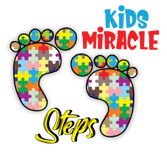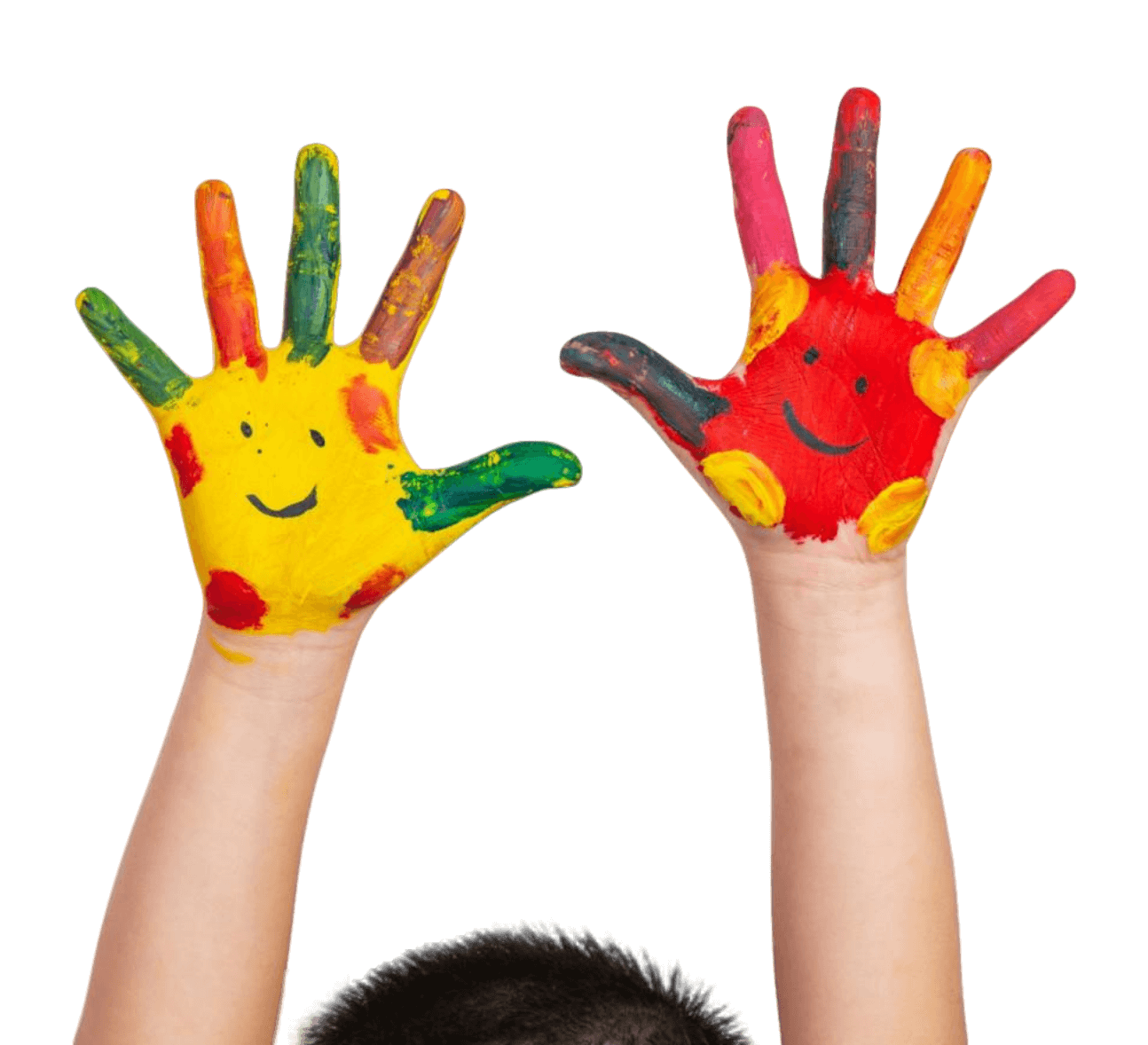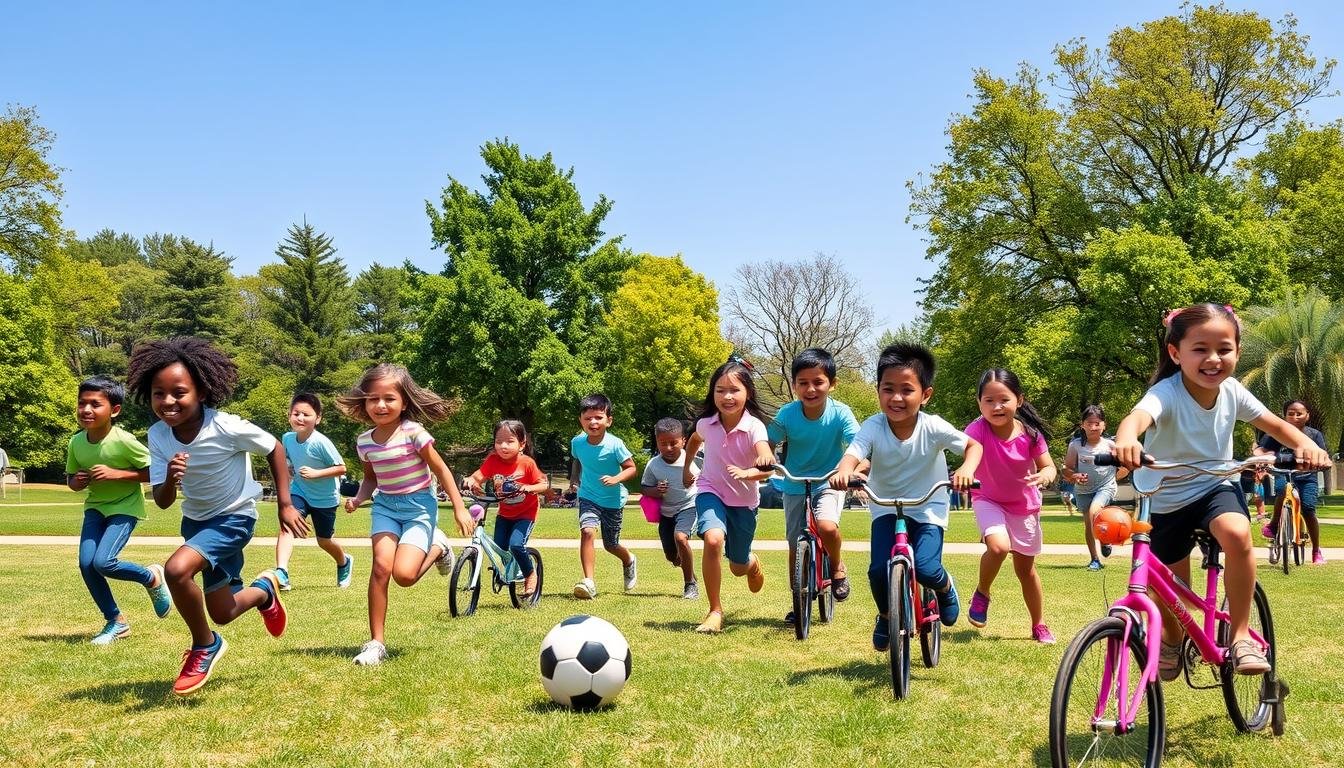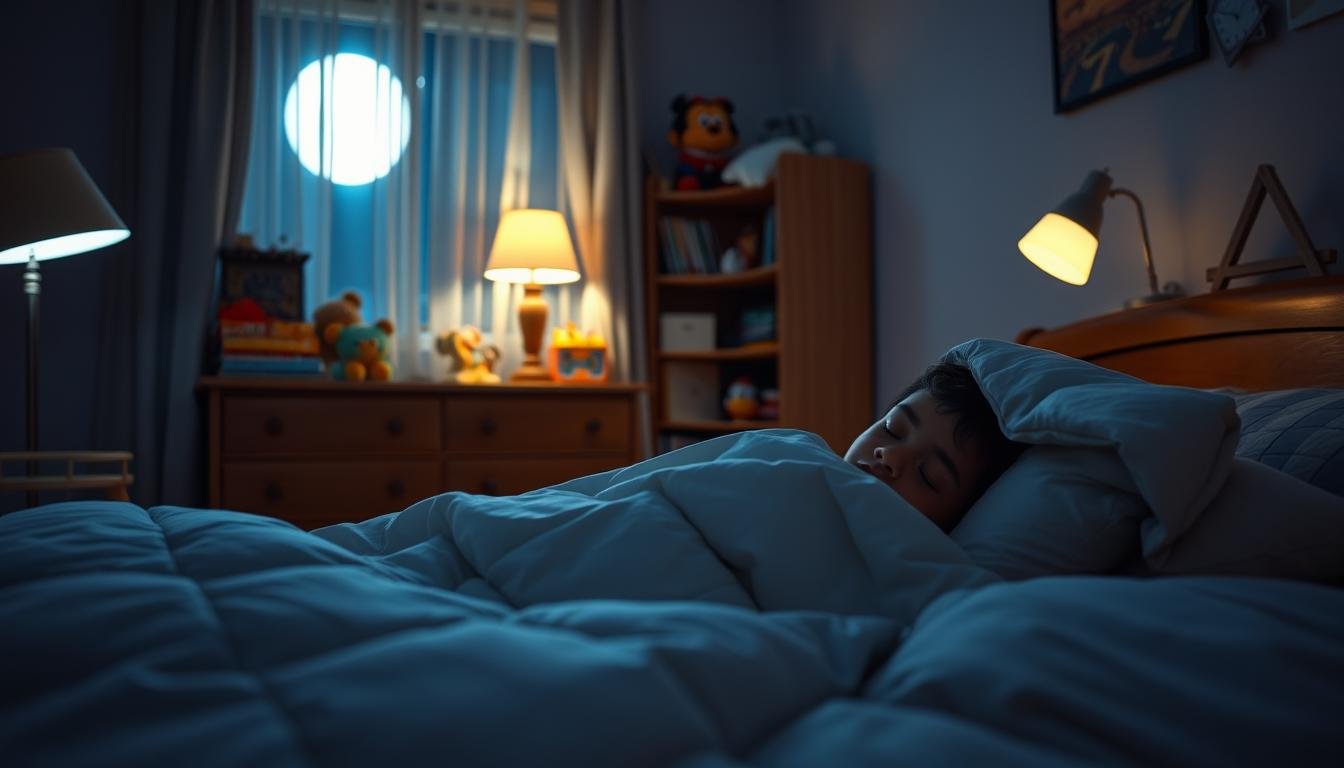Have you seen your child’s face light up after playing tag or riding a bike? That joy is real and linked to movement. In today’s world, where screens are common, only one in four kids in the U.S. gets enough exercise daily. This fact worries us, doesn’t it? We all want our kids to be happy and healthy. That’s why knowing how movement affects mood is key for their mental health. Let’s look at how physical activity can change our kids’ lives.
The Centers for Disease Control and Prevention (CDC) says kids need at least an hour of activity each day. It’s not just for their bodies; it’s also for their minds. Exercise boosts mood and helps kids become happier and more resilient.
Remember when your child came in from playing outside, smiling and flushed? That’s the effect of movement. It’s not just fun; it’s essential for their growing brains and bodies. Let’s find ways to use this natural joy and health for our kids.
Understanding the Science Behind Physical Activity and Mental Health
The brain and body are closely connected, affecting our overall health. Exercise changes our brain chemistry, impacting our mood and mental state. Physical activity releases neurotransmitters that shape how we feel and think.
Regular exercise greatly benefits our mental health. Research indicates that 30 minutes of moderate exercise daily can lift our mood and lower depression risk by 26%. This is due to the increase in feel-good chemicals in our brain.
| Neurotransmitter | Effect on Brain | Impact on Mental Health |
|---|---|---|
| Serotonin | Regulates mood and emotion | Reduces anxiety and depression |
| Dopamine | Enhances motivation and pleasure | Improves focus and happiness |
| Endorphins | Natural pain relievers | Boosts overall well-being |
Exercise influences neurotransmitters and lowers stress hormones like cortisol. This mix improves self-esteem, cognitive function, and sleep. For kids, it boosts confidence, manages anxiety, and enhances focus, leading to a more positive outlook.
The Link Between Movement and Mood: Research-Based Evidence
Studies show a clear link between exercise and better mood. People who are active often have lower depression scores. They also face fewer symptoms of depression. A study of more than 14,000 people found exercise can beat antidepressants for mild to moderate depression and anxiety. This shows how powerful exercise can be for our mental health.
Various exercises have shown to boost mental well-being:
- Strength training
- Running
- Yoga
- High-intensity workouts
- Aerobic flow exercises
These activities, done at a good intensity, help with mood and behavior. For example, heavy weights and sprints can make you feel more alive when you’re down. Meanwhile, aerobic flow exercises help calm anxiety.
| Exercise Type | Mental Health Benefit |
|---|---|
| Strength Training | Improved self-confidence and mood |
| Running | Reduced symptoms of depression and anxiety |
| Yoga | Enhanced relaxation and stress reduction |
| High-Intensity Workouts | Increased engagement and arousal |
| Aerobic Flow Exercises | Decreased rumination and anxious thoughts |
Exercise is a great way to improve mood and behavior. But, it’s important to not overdo it. Paying attention to your body and adjusting your routine is key for the best mental health benefits.
Physical Activity Guidelines for Different Age Groups
Kids need to move! Exercise recommendations vary based on age and physical development. Let’s explore age-appropriate activities for children to stay active and healthy. For little ones aged 3-5, play is key. They should be active most of the day through exploration and fun. Older kids, 6-17, need at least an hour of moderate to vigorous activity daily. This adds up to seven hours weekly.
A mix of exercises is important for growing bodies. Aim for aerobic, muscle-strengthening, and bone-strengthening activities. Here’s a breakdown:
| Activity Type | Examples | Frequency |
|---|---|---|
| Aerobic | Walking, running, swimming, biking, dancing | Daily |
| Muscle-strengthening | Climbing, push-ups, squats | 3 days/week |
| Bone-strengthening | Jumping rope, hopscotch, volleyball | 3 days/week |
Remember, these are guidelines. Every child is unique. The goal is to make physical activity a fun, regular part of their day. By encouraging movement, we’re setting kids up for healthier, happier lives.
Benefits of Regular Physical Activity in Children
Regular physical activity is key for kids’ health, happiness, and brain growth. Studies show active kids enjoy many benefits. These help them feel happy and succeed in life.
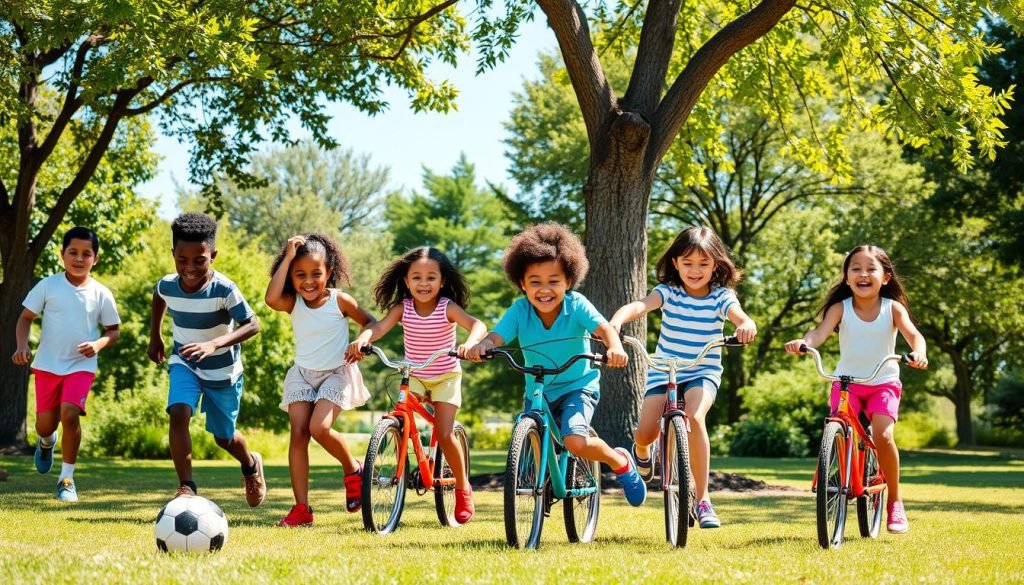
Exercise makes kids feel good by releasing happy chemicals in their brains. It also helps them sleep better and focus more. Setting and reaching fitness goals makes kids feel more confident and proud of themselves. Playing team sports helps them make friends and understand others better.
| Age Group | Recommended Activity | Duration | Benefits |
|---|---|---|---|
| 12 years and older | Aerobic exercise | 30-60 minutes | Significant improvement in positive emotions |
| All ages | Team sports | Regular participation | Enhanced social skills, better self-esteem |
| All ages | Various physical activities | Daily | Stress reduction, improved coping skills |
Exercise helps kids deal with anger and frustration. It teaches them important skills for handling tough times. Regular exercise also helps kids make friends and grow emotionally and socially, no matter their age.
Making Exercise Fun and Engaging for Kids
Getting kids excited about exercise is key to their health and happiness. Fun family activities and outdoor exploration can make active play a natural part of their day. Let’s explore ways to keep kids moving and enjoying it!
Mix up the types of activities to prevent boredom. Take the stairs instead of elevators, walk or bike to school, or have dance parties while tidying up. These small changes add up to big benefits for your child’s well-being.
Outdoor exploration offers endless opportunities for active play. Plan scavenger hunts, family walks before dinner, or games of hide-and-seek. These activities not only boost physical health but also improve cognitive performance and mood.
Consider these fun ideas to get your kids moving:
- Organize play dates with friends focused on active games
- Try exercise-related video games for rainy days
- Sign up for swimming lessons or join a hiking club
- Create obstacle courses in your backyard
- Have dance competitions during TV commercial breaks
Remember, the goal is to make exercise enjoyable. When kids have fun while being active, they’re more likely to develop a lifelong love for physical activity.
| Activity | Benefits |
|---|---|
| Standing desks in classrooms | 7-14% improvement in cognitive performance |
| Math while playing basketball | 6% increase in cognitive performance, 16% in motivation |
| Physical movement while learning words | 73% better recall after two months |
| Drawing concepts | Double retention rates compared to writing or reading |
Supporting Children with Special Needs Through Movement
Kids today are more sedentary than ever. This is especially true for children with special needs who face unique barriers to physical activity. Adaptive physical activities and inclusive exercise programs are crucial for these children’s well-being.
Sensory-friendly workouts can help children with special needs regulate their energy and emotions. Dancing, stretching, and other physical activities contribute to better self-regulation. These activities engage the brain in complex ways, leading to improvements in daily life skills.
Cybercycling is an innovative approach that’s gaining popularity. It combines stationary biking with virtual reality, making exercise engaging and fun. This method allows children to participate at their own ability level while enjoying video games and virtual courses.
Visual schedules and social stories are effective tools in adaptive physical activities. They help reduce anxiety and improve self-regulation by providing clear expectations. Positive reinforcement during inclusive exercise programs encourages better emotional and behavioral management.
Mindfulness techniques, like deep breathing and guided imagery, can be incorporated into sensory-friendly workouts. These practices help children focus on the present moment and manage their emotional responses effectively.
With the right approach, children with special needs can reap the benefits of regular physical activity. It’s not just about fitness – it’s about rewiring the brain, boosting confidence, and improving overall quality of life.
The Role of Parents and Educators in Promoting Active Lifestyle
Parents and teachers are key in shaping kids’ views on exercise. They set examples that kids follow, leading to a healthier lifestyle. School sports and family activities at home both play a part in teaching fitness. Studies show kids who see their parents active tend to be more active too. Doing sports or outdoor activities together strengthens family bonds. It also helps kids grow and develop better.
Teachers can help by adding movement to school days and keeping recess important. Physical education classes help kids with skills, friendships, and teamwork. These lessons are the start of a healthy lifestyle for life.
| Parental Involvement | Percentage |
|---|---|
| Active Involvement | 65% |
| Praise and Understanding | 78% |
| Directive Behavior | 45% |
| Parental Pressure | 32% |
The table shows how parents can help by being supportive but also giving kids freedom. This way, kids can enjoy sports for years to come.
Conclusion: Embracing Movement for Happier, Healthier Kids
Physical activity is key for kids’ growth. It boosts mood and helps in school. Kids aged 6-17 need 60 minutes of activity daily. Preschoolers should stay active all day. Studies support these rules. The 2018 United States Report Card on Physical Activity for Children and Youth shows exercise’s value. It’s not just for health – it also helps in school. At Kids Miracle Steps, we see how movement changes lives.
Parents and teachers, you’re crucial in teaching kids to love exercise. Making it fun helps kids stay healthy and happy. It’s not about looks, but about being strong and healthy through fun activities. Let’s all support an active lifestyle for better kids!
